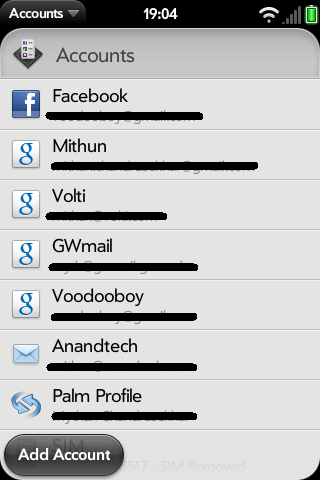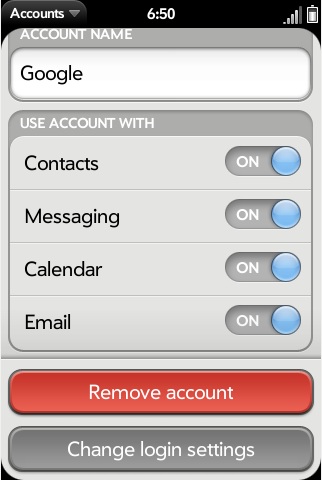webOS 2.0 Overview
by Mithun Chandrasekhar on February 3, 2011 6:05 PM ESTSynergy Revisited
The next update that webOS brings is to the contact system, what HP calls “Synergy”. The contact management system in webOS is beautiful in its concept; you have a central repository of all your contacts and each contact entry in itself acts as a collection of all information, aggregated from different sources, for that one person. So selecting Anand in my contact book would display his mobile, work, and home numbers; his AIM, Google, Yahoo, and Exchange addresses; and links to his Twitter, Facebook and Linkedin profiles (with profile pictures automatically applied as the caller ID). All of this happens without you having to do much more than enter your username/password for each of the social network accounts.



Account management is now more straightforward, but not perfect
As mentioned earlier, while a great idea, the nightmare starts when you now have hundreds of so-called contacts added to your phone, with no way or form of selecting whom to add and whom to ignore. And to add to the pain, webOS by default is not totally accurate in linking, e.g. “Anand” to his Facebook account. So you will have to go in and manually link accounts if you want a "clean" contact book.
With webOS 2.0, HP has partially addressed this issue. While webOS will still try to go ahead and add every Tom, Dick, and Harry to your contact list, you have a modicum of control over what gets synced from each account. With “Accounts”, you now have a single location from where you can add new accounts and choose if you want calendars synced from Google, contacts from Facebook added to your contact list, and/or AIM contacts added to your messaging list. I still feel it needs to provide control, one granularity-level lower, where I can choose which particular Facebook contact I want added to my list. But this all or nothing approach is certainly a marked improvement over not being given an option at all!










46 Comments
View All Comments
ssj4Gogeta - Thursday, February 3, 2011 - link
Well, that sounds pretty bad. Google needs to advertise Android as a Google product. That will definitely help.Belard - Friday, February 4, 2011 - link
"4 OS Smartphones"? Uh, theres more than 4 on the market. But if WebOS(HP) can make a dent in the market place, it would be 6th major contender. Linux would be 7th and its dying out - killed by Android (Which is based off Unix).Around 2010, the smart phones :
1 - 36% = Symbian (Nokia - blah)
2 - 25% = Android (Samsung, Motorola, LG, HTC, SONY)
3 - 17% = iPhone
4 - 15% = RIM (Blackberries)
5 - -3% = Windows Mobile
6 - 2% = Linux (and getting smaller)
7 - -1% = WebOS 1.x and everything else including Sony's old system.
WebOS 2.0 is competing with 4~5 solid major competing systems.
A bit of fun. First SMART Phone is by IBM. The Simon from 1994. It has a huge mono-LCD touch screen, no actual buttons. Use your finger or a stylus to operate.
Looking at the screensshots, it looks great. Clean and simple. In ways, there are still issues with Android. I'm still on 2.1 with my Galaxy which isn't perfect, other than its screen.... and there are some interface issues that are harder than it should be.
Setting up an alarm, in which the screen button display is alpha numeric?!
rhangman - Friday, February 4, 2011 - link
Don't forget Samsung Bada. Surprisingly decent OS and the hardware is essentially the same as their Android/WM7 phones.Conficio - Thursday, February 3, 2011 - link
I like webOS too. sounds quite a bag of good ideas.But the hardware spec seems to be last years boat. by the time that hits the networks we are talking about dual core A9, etc.
The interesting part would be if HP could use this to build UIs for all its devices: phone, tablet, printer, scanner, monitor/TV remote, monitor OSD, cameras, notebook instant on, netbook instant on, etc.
Ahh, and make it open source and engage many hardware manufacturers. Google has done it, webOS does need too.
One more question, what is the app install story/marketplace? That is key for developers, isn't it?
Cyborg7th - Friday, February 4, 2011 - link
The pre's specs are last years boat... or more to the point, mid 2009. But at the time of release it was just as powerful, and in some areas better, than the other phones on the market.HP does plan on using webOS on tablets and printers so far that I know of, and possibly more in the future.
As for open source, webOS has Android blown away in that department. I have full access to everything on my pre, including a terminal interface which I can run shell commands on. Thanks to the homebrew guys/gals you can change almost everything on the phone, including overclocking it. My pre is curretly clocked at 1 ghz with custom voltages.
The last question is where I feel HP needs to step up their game on the software side of things. The current app store sucks to be blunt. I never use it anymore after loading preware onto my phone. But while webOS doesn't have a ton of apps available, a lot of them are free.
ChronoReverse - Friday, February 4, 2011 - link
That seems like a curious thing say about "blowing away Android" when the examples you provided are all possible on Android as well. Perhaps you meant to say iOS?Cyborg7th - Saturday, February 5, 2011 - link
Possible on Android... sure... now get back to me when you can do it without rooting your phone first.tenkom - Saturday, February 5, 2011 - link
It is not exactly officially supported on webos either and over clocking does require you to flash a new kernel. Many android phones are very easy to root so I don't think that is a very good argument.Cyborg7th - Saturday, February 5, 2011 - link
That was the arguement to begin with. My statement was about webos being more open than android. Out of the box, webos on any of the phones does not have to be rooted.Conficio - Thursday, February 3, 2011 - link
I'd think that many of these app features would be great as kind of a dashboard on Windows/Linux as well.So make a virtual phone as a dashboard (many laptops have multi finger mousepads and desktops start using it too - Apple?). Then sync the the phone and the dashboard app, allow any sort of sizing, make it a screensaver, etc.
Same for media access on your media settop box?
HP has the ability to do it, especialy if they OSS it.